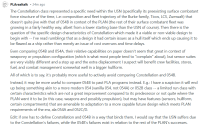Speaking of which, @Temstar and @Blitzo had a brief exchange on the 054B FFGs based on quotes and comments by the Guancha Trio in a recent podcast.
Yes, the screenshots are from r/LCD, but I think the contents are rather worthwhile to be posted here.


In the meantime, given that there could be 4x new 054B FFGs to be built during the coming 15FYP (and potentially up to 8 units) - I think it's more suitable to say that the 054B-class still holds its worth quite well, even if/when the 054B FFGs are mainly serving as placeholders while the PLAN is waiting for the serial production of the next-generation FFGs to spin up. This is also with the purview of the 054A FFGs being very likely to have its production terminated at 50 hulls.
Yes, the screenshots are from r/LCD, but I think the contents are rather worthwhile to be posted here.


In the meantime, given that there could be 4x new 054B FFGs to be built during the coming 15FYP (and potentially up to 8 units) - I think it's more suitable to say that the 054B-class still holds its worth quite well, even if/when the 054B FFGs are mainly serving as placeholders while the PLAN is waiting for the serial production of the next-generation FFGs to spin up. This is also with the purview of the 054A FFGs being very likely to have its production terminated at 50 hulls.
Last edited:
